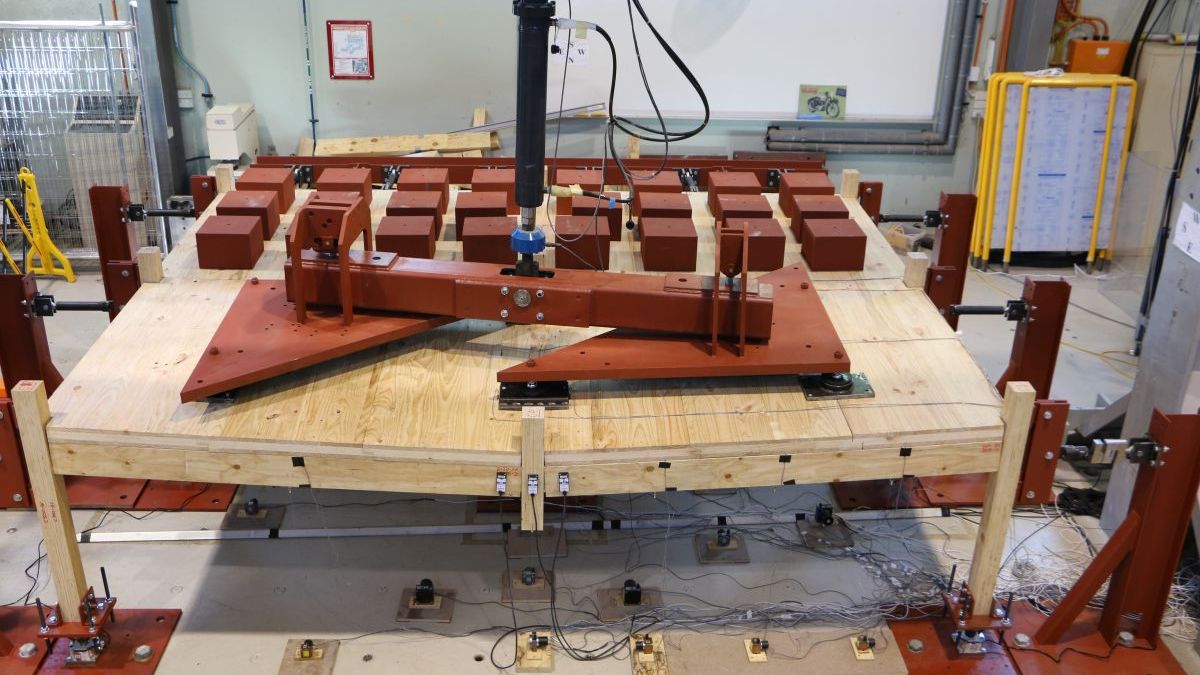
Progressive collapse is characterised by a disproportionate and severe collapse of a structure due to local failure, which is usually caused by accidental or abnormal loadings - such as gas explosion, fire, blast or vehicular collision. As the height of timber buildings increases, so do their potential risks of progressive collapse. While progressive collapse resistance of concrete and steel buildings has been widely researched, very limited published studies have focussed on mass timber buildings.
This project aims to understand the progressive collapse mechanisms of mass timber frame systems with CLT floors through a comprehensive experimental program. Advanced numerical tools, calibrated against the available experimental tests, will also be used to quantify the factors influencing the progressive collapse mechanisms of tall frame mass timber buildings through parametric studies. Edge column removal will be the focus of this research but other column removal scenarios will be investigated in the future.
Research Showcase
Published Articles
Engineering Structures "Experimental study on the quasi-static progressive collapse response of post-and-beam mass timber buildings under corner column removal scenarios"
Chunhao Lyu advised, "Many thanks to my supervisors Benoit Gilbert, Hong Guan, Ian Underhill, and co-authors Shanmuganathan Gunalan, Hassan Karampour, for their continuous support. Also, thanks to all industry partners, Arup, Leadlease, XLam, Northrop, and ARC Future Timber Hub".
Engineering Structures "Experimental study on the quasi-static progressive collapse response of post-and-beam mass timber buildings under an edge column removal scenario"
Engineering Structures "Experimental collapse response of post-and-beam mass timber frames under a quasi-static column removal scenario"
Engineering Structures "Experimental dynamic collapse response of post-and-beam mass timber frames under a sudden column removal scenario"
Engineering Structures "Scaling effect on the moment and shear responses of three types of beam-to-column connectors used in mass timber buildings"
CLT Band-beams, Robustness and Composite Systems - PTEC Part 2
WoodSolutions TimberTalks Series - The conversations were taken at the Pacific Timber Engineering Conference (PTEC 2019) held in Brisbane in July. Benoit Gilbert from Griffith University speaks on robustness at 13.00.
New strength and safety tests pit timber against concrete and steel
Create Digital - Griffith University’s Associate Professor Benoit Gilbert has been putting timber to the test, using high-tech machinery to better understand how timber behaves in a variety of situations.
Researchers put tall timber to the test
Built Offsite - A key member of the team undertaking the testing is Associate Professor Benoit Gilbert from Griffith’s School of Engineering and Built Environment. He confirmed the team was specifically looking at engineered solid wood products, such as Laminated Veneer Lumber (LVL), Glue laminated timber (Glulam) and Cross Laminated Timber (CLT) and their capabilities in collapse resistance, adding that this was of particular relevance for offsite construction.
- Investigating the progressive collapse mechanisms of tall frame mass timber buildings through experimental tests performed on scale substructures and edge column removal.
- Developing advanced numerical tools calibrated against the available experimental tests and use them to quantify the factors influencing the progressive collapse mechanisms of tall frame mass timber buildings through parametric studies.
- Developing and test new connectors to enhance the progressive collapse resistance of tall frame mass timber buildings.
- Verifying the accuracy of the current design and detailing guidelines to resist progressive collapse in current design specifications.



